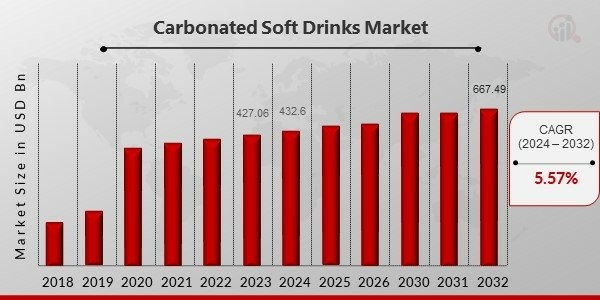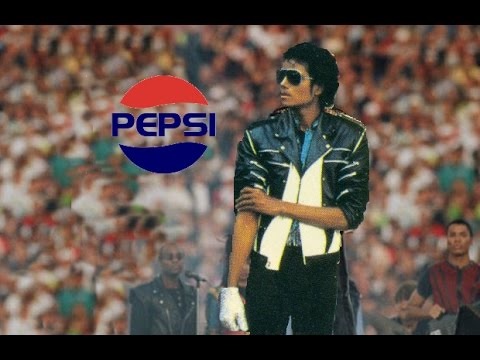The beverage market has undergone significant changes over the past decade. Consumers, now more informed than ever thanks to easy access to information, have started turning away from once-popular sugary carbonated drinks in favour of healthier and often more sustainable alternatives.
Beverage manufacturers are under considerable pressure and are forced to introduce new products that can meet changing tastes and adapt to new consumer behaviour. A large number of people today carefully read ingredient labels, are interested in the origin of ingredients, and check sugar content or the presence of artificial sweeteners. Even traditional brands like Coca-Cola and Pepsi, which seem to have an unshakable position and act dominantly toward others, must dynamically adjust their strategies to maintain their place in the market.
According to forecasts, however, the future of the carbonated soft drink market does not look bad at all.
 Carbonated Soft Drink Market, 2023–2032 (in billions USD); Source: marketresearchfuture.com
Carbonated Soft Drink Market, 2023–2032 (in billions USD); Source: marketresearchfuture.comDespite the vast size of the market, the biggest players are working hard to keep the competition at bay. Being at the very top is no easy task. And so, Coca-Cola and PepsiCo have been engaged in an advertising war for years—one that has gone down in history as the “Cola Wars.” This advertising battle has essentially been ongoing since the founding of PepsiCo, but it reached its peak intensity in the 1970s.
Coca-Cola – experiences, sharing, and Christmas
Coca-Cola is the “child” of American pharmacist John Stith Pemberton from Atlanta, and was born in 1886. The drink was originally developed as a medicinal tonic and was sold in pharmacies. The name “Coca-Cola” was coined by Pemberton’s accountant, Frank M. Robinson, who also created the iconic logo.
At the time Coca-Cola was first introduced to the market, television didn’t exist yet, so the company relied on print advertising. In Coca-Cola’s late 19th-century ads, women were often depicted modestly sipping a glass of the soft drink. The goal was to associate the beverage with the upper class. After all, who wouldn’t want to be seen drinking the same beverage as admired members of high society? The first celebrity to become the face of Coca-Cola was vaudeville dancer and singer Hilda Clark.
In the 1920s, the brand began incorporating men into its advertisements, aiming to ensure it appealed to both genders. Another strategy at the time was emphasising Coca-Cola’s qualities, which the company achieved through various slogans. Coca-Cola was slowly but surely instilling the idea in potential consumers’ minds that drinking the beverage throughout the day would provide a boost of energy.
Coca-Cola’s first television advertisement was broadcast in the United States in 1950, on Thanksgiving Day.
Video: First Coca-Cola advertising on TV
Worth mentioning is also an ad from the early 1950s in which Coca-Cola capitalised on the popularity of the beautiful Marilyn Monroe.
Video: Coca-Cola – Marilyn Monroe
Coca-Cola’s advertising strategy gradually evolved from initial print ads and radio spots to television ads and finally to digital campaigns. A significant milestone was the “Share a Coke” campaign, which started in Australia in 2011 and later expanded to more than 80 countries. The campaign involved printing the 150 most popular names in the country on the front of bottles and cans in Coca-Cola’s signature font. This helped the brand foster a personal connection with customers.
Video: Coca-Cola – Share a Coke
Coca-Cola brought this iconic campaign back in 2018 and has decided to repeat it again this year. The goal of this year’s Share a Coke campaign is to remind especially Generation Z consumers that building connections only requires a simple act of sharing. The new campaign combines digital and in-real-life experiences with greater opportunities for sharing and customisation. Starting in April, consumers will find Coca-Cola cans and bottles with names on store shelves. The gradual global rollout will eventually cover more than 120 countries.
The Coca-Cola mobile app and QR codes on the packaging serve as gateways to the digital Share a Coke hub, where fans can customise Coca-Cola packaging with additional names and gain access to the interactive digital experience called “Share a Coke Memory Maker.” In this experience, users can create personalised videos with their own content and memes to share with friends. The purpose is to celebrate friendship by turning everyday moments into lasting, shared memories. Other elements of the new Share a Coke campaign include the film “The Magic of Sharing,” collaborations with influencers aimed at reaching Generation Z on relevant social media platforms, bold out-of-home (OOH) creative emphasizing the energy and excitement of friendship, “Share a Meal” bundles at McDonald’s restaurants in selected countries, and more.
Coca-Cola has won several awards at the international creativity festival Cannes Lions for its campaigns. For example, the “Small World Machines” campaign by Leo Burnett, which connected people from India and Pakistan through interactive vending machines, was awarded six Lions in 2013 for its innovation and promotion of peace between nations.
Video: Coca-Cola – Small World Machines
Among Coca-Cola’s most iconic ads are, of course, the Christmas campaigns featuring Santa Claus. He first appeared in a Coca-Cola Christmas ad in 1931. A lucky move that has proven successful for the brand up to the present day! Over time, Santa was joined by Christmas trucks and other festive elements. In any case, Santa Claus was a brilliant move for the brand, and according to Coca-Cola, the world still needs more Santas today.
Video: Coca-Cola – The world needs more Santas
Coca-Cola is known for its ability to quickly respond to current events and trends. For example, during major sporting events like the Super Bowl or significant cultural occasions, the brand often releases special product editions or launches thematic advertisements that resonate with the prevailing mood of society. The brand targets a wide range of customers across age groups and cultures. It strives to be perceived as a symbol of joy, refreshment, and shared experiences. Its strategies include localising campaigns for different markets, collaborating with local influencers, and sponsoring cultural and sporting events. It also utilises product placement—for instance, Coca-Cola appeared four times in the successful film E.T. the Extra-Terrestrial.
Pepsi – youth and modern lifestyle
Pepsi was first introduced in 1893 by pharmacist Caleb Bradham from New Bern, North Carolina. At that time, the drink was still called “Brad’s Drink”. In 1898, it was renamed “Pepsi Cola”. This name was said to refer to its supposed positive digestive effects and the flavour of cola nuts.
In December 1950, the brand aired its first television ad. Besides being a “keeping up with technological advancements” and thus a huge step in advertising, it was also notable for featuring James Dean. It was James Dean’s first paid television appearance and the beginning of his iconic career. This ad marked the first shift away from promoting health benefits and instead highlighted a new aspect of the drink—the side effects that contribute to increased energy.
Video: Pepsi – first James Dean TV appearance
In 1963, the “Pepsi Generation” campaign was launched, targeting the younger generation and emphasising a modern lifestyle. In the 1980s and 1990s, Pepsi collaborated with stars like Michael Jackson and Britney Spears, strengthening its youthful and innovative image.
Video: Pepsi Generation – Michael Jackson
Currently, Pepsi focuses on innovation and personalisation. In 2024, it introduced the “Pepsi Smart Can” at the Cannes Lions festival – a can equipped with a digital screen, motion sensors, and advanced sound technology, providing an interactive experience for consumers.
Pepsi is known for its ability to quickly respond to current trends and events. An example is the “Better with Pepsi” campaign from 2022, which won two Gold, one Silver, and one Bronze Lion at the Cannes Lions festival.
Video: Pepsi – Better with Pepsi
Pepsi traditionally targets younger demographic groups, emphasises a modern and innovative image, and often collaborates with popular musicians and celebrities. It also focuses on personalisation and interactive marketing campaigns.
Cola Wars
Two roosters in one henhouse never promise peace. The rivalry between Coca-Cola and Pepsi, known as the “Cola Wars”, has led to numerous advertising battles and has been ongoing for over a hundred years. Since the 1970s, both companies have invested significant sums in comparative advertising. This period is considered the most explosive phase of the advertising war between these beverage giants.
In 1975, Pepsi launched the legendary marketing campaign “Pepsi Challenge”, in which it organised blind taste tests. Customers were asked which drink they preferred without knowing what they were drinking. The results often favoured Pepsi. The campaign had a huge impact and, for the first time, seriously challenged Coca-Cola’s leading position.
Video: Pepsi Challenge
By the way, Pepsi brought back this campaign this year. The brand wants to prove that PEPSI Zero Sugar tastes better and is more refreshing than Coke Zero Sugar.
In 1985, Coca-Cola made a controversial move. They changed the recipe and launched “New Coke”. The goal was to appeal to a younger generation and lure them away from the competition. However, this move sparked massive public backlash. Customers showed their conservative side, expressing strong displeasure that the brand had abandoned its classic taste. Within a few months, Coca-Cola had to revert to the original recipe under the name “Coca-Cola Classic”—and paradoxically, this ultimately strengthened the brand thanks to the loyalty of its fans.
In the 1980s and 1990s, the battle also moved into television and the Super Bowl, where both companies competed to create the most creative and entertaining ads. After 2000, the fight partially shifted from TV spots to the digital space, social media, and global marketing. Let’s take a look at some of the other key ads that are part of the Cola Wars.
In the 1995 Pepsi ad titled “Vending Machine Dollar”, a young boy wants to buy a can of Pepsi from a vending machine. To get it, he first has to remove two cans of Coca-Cola, which come out first. Once he finally gets his Pepsi, he leaves the Coca-Cola cans on the ground and walks away happily.
Video: Pepsi – Wending Machine
In 2025, Pepsi launched a commercial called “Any Time” in response to Coca-Cola’s campaign titled “Half Time.” In this ad, Pepsi emphasises that its drink is suitable for consumption anytime, not just during sports game halftimes, directly challenging Coca-Cola’s marketing strategy. This campaign signals a renewed intensity in the rivalry between the two brands.
Video: Pepsi – Any Time
In 2025, Coca-Cola launched a campaign in Pakistan focused on the popular local sport of tape-ball cricket. This campaign, featuring a limited edition of bottles, is seen as an attempt to divert attention from Pepsi, the traditional sponsor of the Pakistan national cricket team. Coca-Cola used this strategy to strengthen its market position during a major sporting event. The company stated that the campaign is meant to be “a nostalgic and enjoyable experience for everyone who has ever played street cricket in Pakistan.”
Where two are fighting, the third wins
The advertising war has been ongoing for more than a hundred years. In this case, the proverbial “third party” is the customer, who has benefited from the continuous improvement of the brands. The rivalry has also been beneficial to the brands themselves, leading to innovations, enhanced marketing, and market segmentation. Both brands have built a strong global identity and have become symbols of American culture. The battle has also demonstrated the power of branding and the emotional connection customers have with the brands — many customers show deep loyalty to “their” brand.
Even such strong brands must not rest on their laurels. Today’s digital world and highly competitive market demand dynamism. Besides traditional television advertising, which still remains one of the most effective advertising channels, brands build their stories on social media, collaborate with influencers, and create personalised content for specific target audiences.
Both Coca-Cola and Pepsi are global, very strong brands; however, they must take into account the new generation of consumers who often prefer local, eco-friendly, and authentic brands. The future of these beverage giants depends on their ability to listen to consumers, adapt faster than ever before, and innovate without losing their identity. The advertising battle between Coca-Cola and Pepsi will undoubtedly continue.

